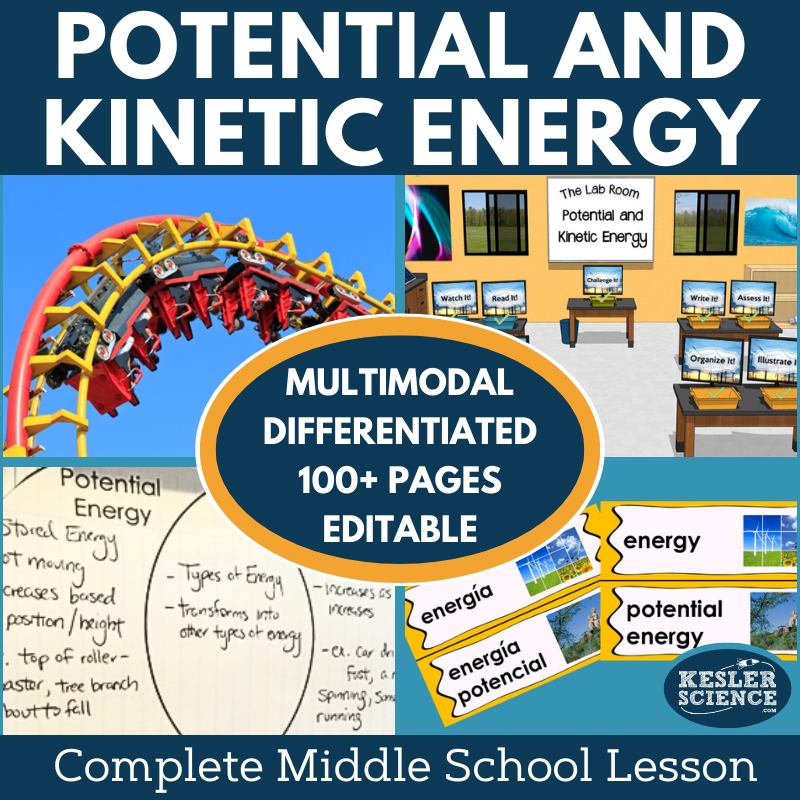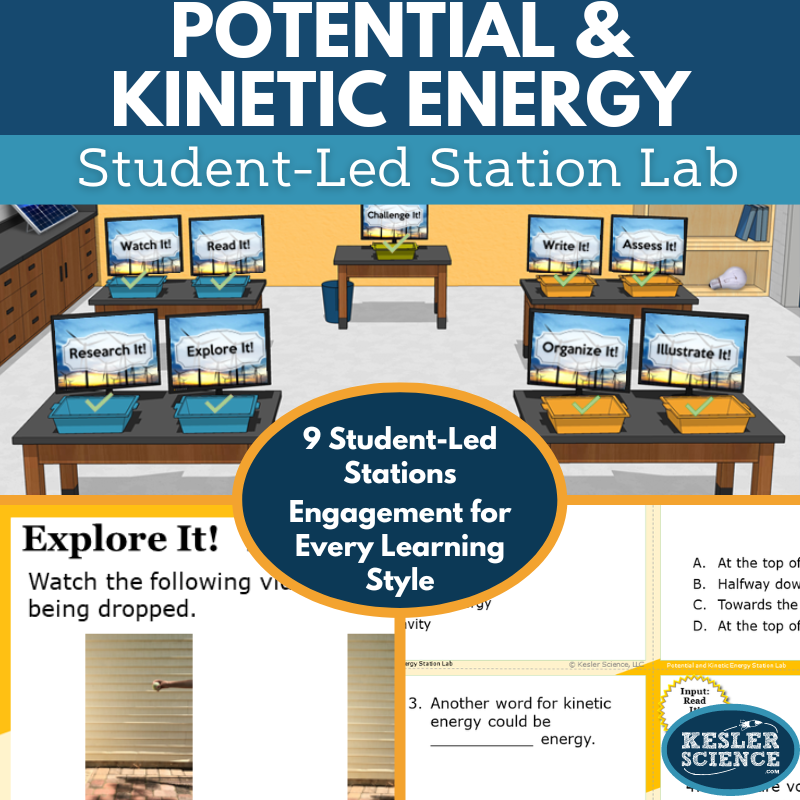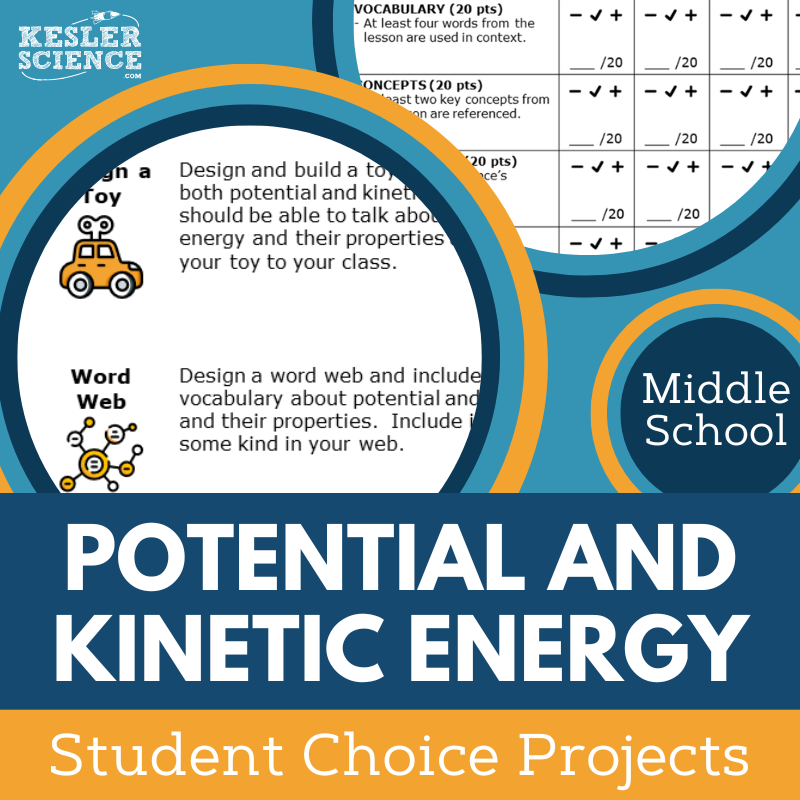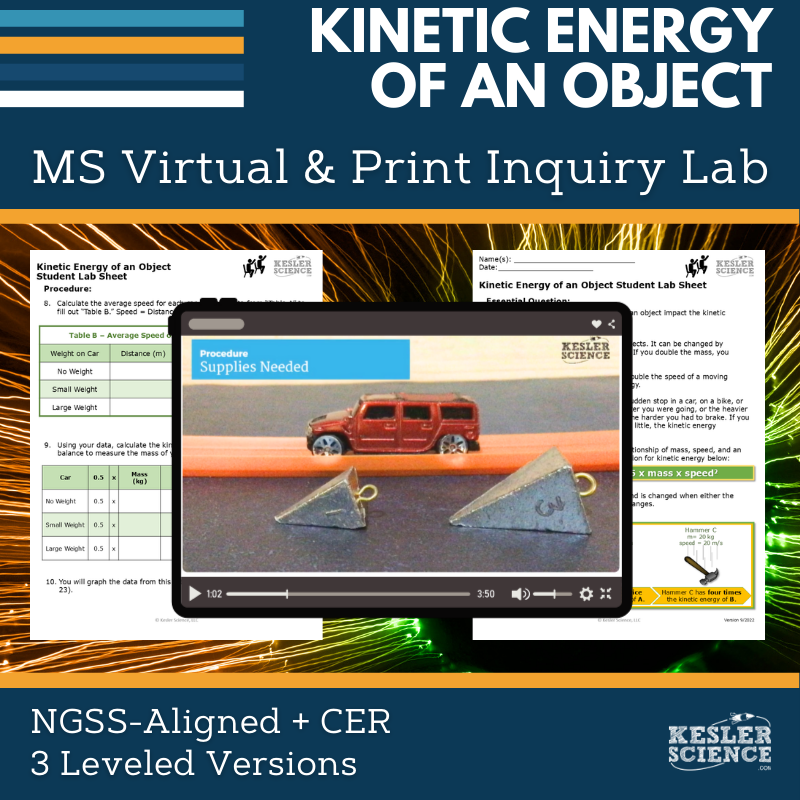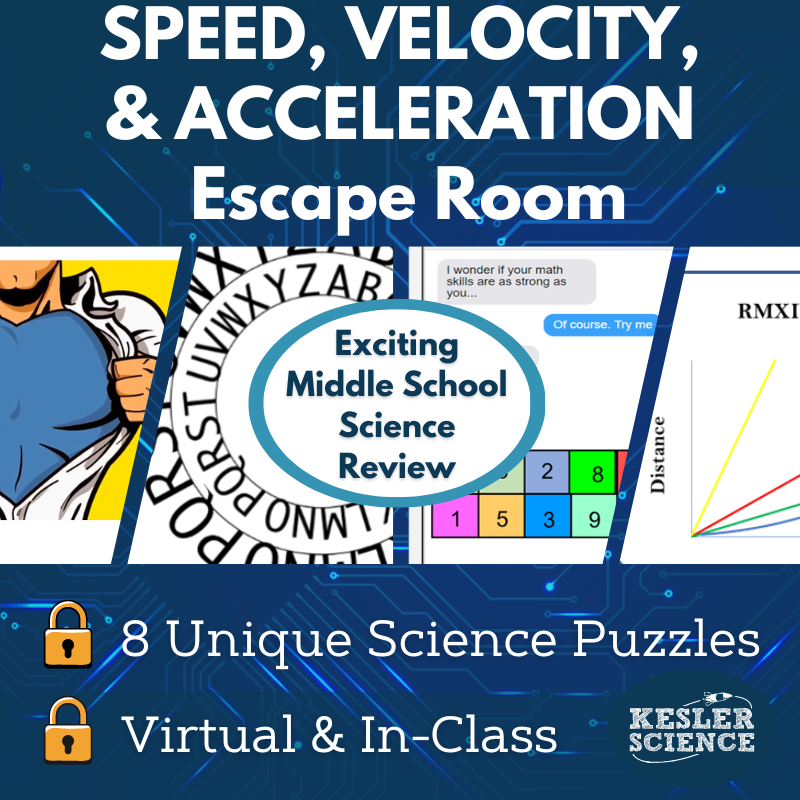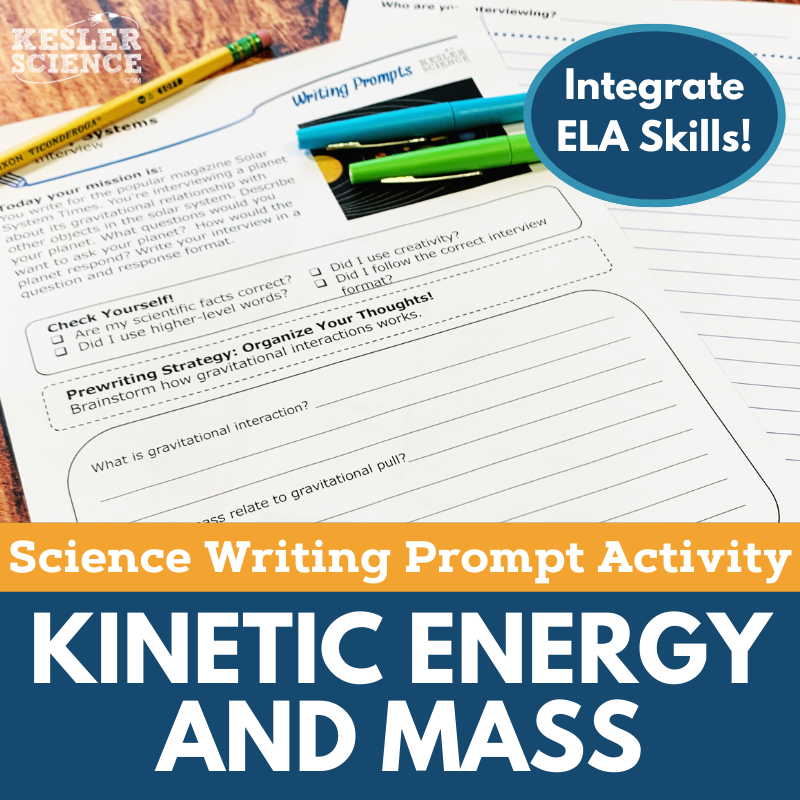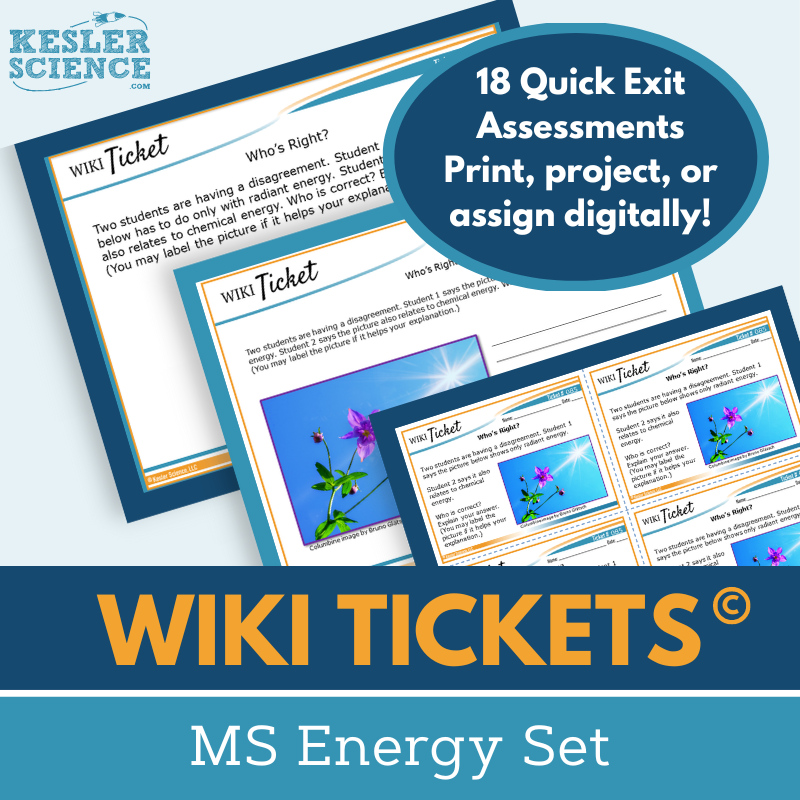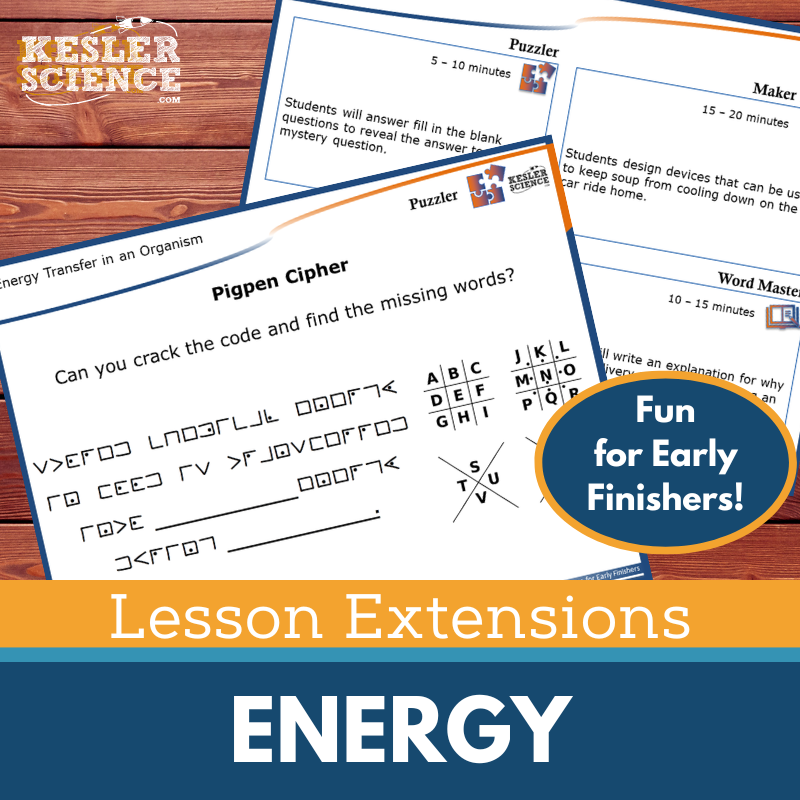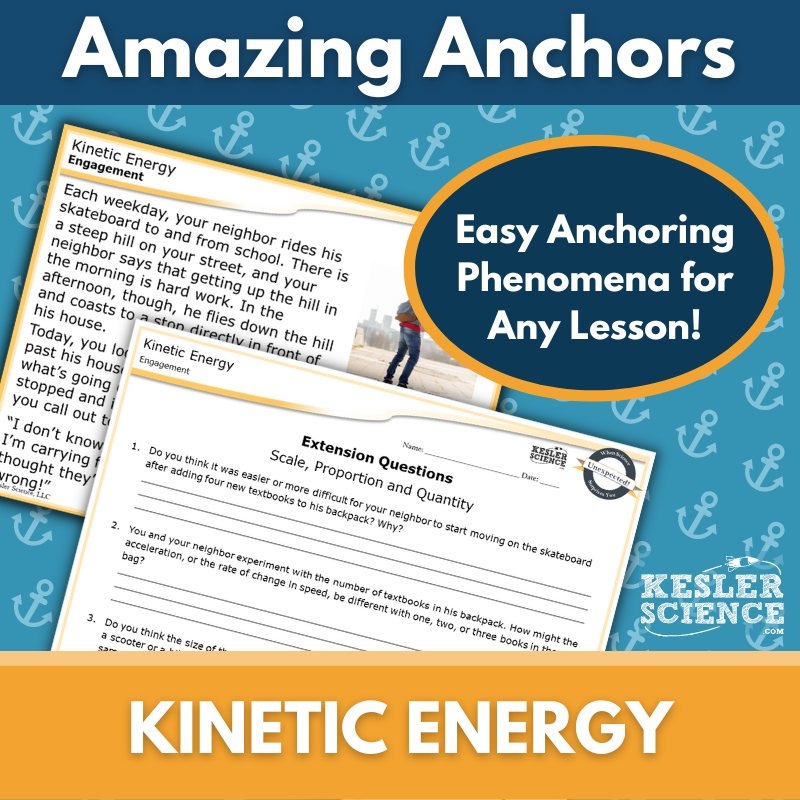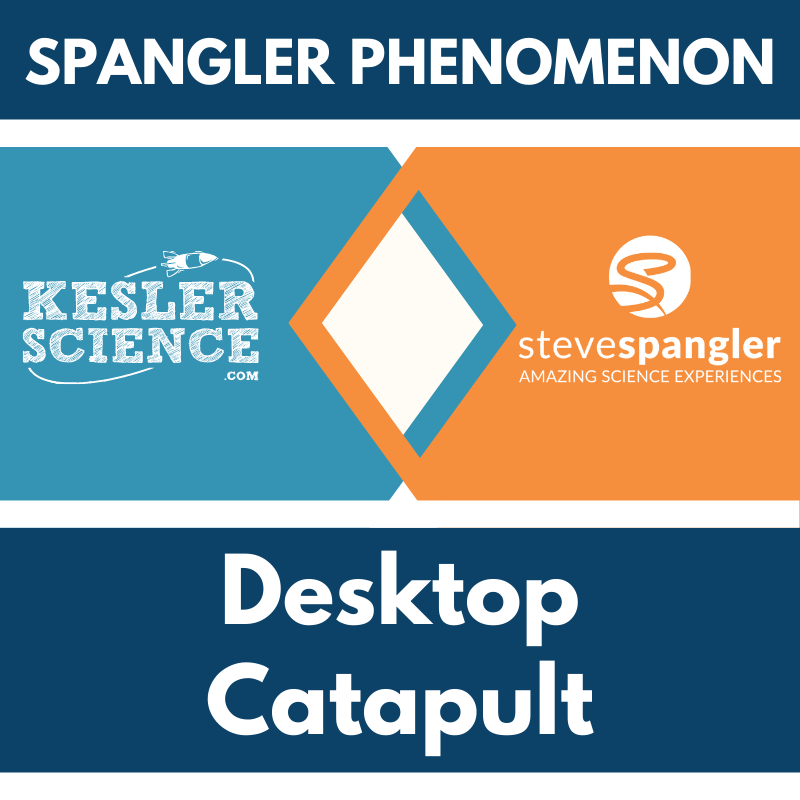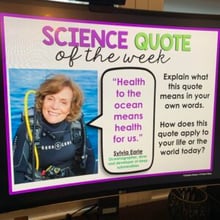Kinetic Energy of an Object Activities for Middle School Science
This student-led 5E lesson engages middle school students in exploring potential and kinetic energy through interactive activities, hands-on experiments, and differentiated learning tools. The resources below will give students a comprehensive understanding of kinetic energy. All of the following materials are also included in the Kesler Science Membership.
The Kesler Science Potential and Kinetic Energy 5E Lesson is a comprehensive, student-led unit designed for middle school classrooms. It includes editable presentations, worksheets, choice projects, and assessments, all requiring minimal prep. Aligned with NGSS and TEKS, this lesson supports differentiated and multimodal learning, with printable and digital formats available. Spanish translations are included for vocabulary, reading passages, and interactive notebook pages.
Following the 5E Model, the lesson begins with engagement activities, word wall cards, and class discussions. Exploration features a differentiated, student-led station lab with nine stations, offering hands-on experiments, reading passages, research tasks, videos, and interactive exercises. Explanation includes editable PowerPoints, interactive notebooks, and note-taking templates. Elaboration provides student-choice projects to deepen understanding, while evaluation includes STAAR 2.0-aligned assessments, review questions, and worksheets for discussion or practice.
The resource is flexible for both in-person and virtual learning, ensuring accessibility and engagement for all students.
The Kesler Science Potential and Kinetic Energy 5E Lesson is a comprehensive, student-led unit designed for middle school classrooms. It includes editable presentations, worksheets, choice projects, and assessments, all requiring minimal prep. Aligned with NGSS and TEKS, this lesson supports differentiated and multimodal learning, with printable and digital formats available. Spanish translations are included for vocabulary, reading passages, and interactive notebook pages.
Following the 5E Model, the lesson begins with engagement activities, word wall cards, and class discussions. Exploration features a differentiated, student-led station lab with nine stations, offering hands-on experiments, reading passages, research tasks, videos, and interactive exercises. Explanation includes editable PowerPoints, interactive notebooks, and note-taking templates. Elaboration provides student-choice projects to deepen understanding, while evaluation includes STAAR 2.0-aligned assessments, review questions, and worksheets for discussion or practice.
The resource is flexible for both in-person and virtual learning, ensuring accessibility and engagement for all students.
The modular, student-led station lab focuses on potential and kinetic energy, engaging middle school students in a dynamic learning experience. The activity is designed to be low-prep for teachers while allowing students to take charge of their own learning. Throughout the stations, students explore and compare concepts of potential and kinetic energy in a hands-on, interactive way, with a teacher guiding rather than directing the learning process. The nine stations include all necessary resources, signage, and task cards, enabling students to complete the activities independently or in small groups.
The stations are divided into input and output categories. In the input stations, students encounter new concepts through various methods, including hands-on demonstrations, research tasks, readings, and videos. Each station provides a different modality for learning, with differentiated resources available, such as reading passages in both English and Spanish, to accommodate diverse learners. The output stations allow students to showcase their understanding through activities like organizing concepts with manipulatives, illustrating energy models, and writing short responses. These activities help reinforce students' knowledge and improve retention.
Additionally, a bonus challenge station offers extension activities for advanced learners or early finishers. These activities include games, puzzles, and mini-projects that deepen understanding and extend learning. The station lab is designed to be adaptable for both in-class and virtual learning environments, providing flexibility for various teaching settings. With its student-centered approach, this activity promotes active learning and critical thinking while covering essential science concepts related to potential and kinetic energy.
The modular, student-led station lab focuses on potential and kinetic energy, engaging middle school students in a dynamic learning experience. The activity is designed to be low-prep for teachers while allowing students to take charge of their own learning. Throughout the stations, students explore and compare concepts of potential and kinetic energy in a hands-on, interactive way, with a teacher guiding rather than directing the learning process. The nine stations include all necessary resources, signage, and task cards, enabling students to complete the activities independently or in small groups.
The stations are divided into input and output categories. In the input stations, students encounter new concepts through various methods, including hands-on demonstrations, research tasks, readings, and videos. Each station provides a different modality for learning, with differentiated resources available, such as reading passages in both English and Spanish, to accommodate diverse learners. The output stations allow students to showcase their understanding through activities like organizing concepts with manipulatives, illustrating energy models, and writing short responses. These activities help reinforce students' knowledge and improve retention.
Additionally, a bonus challenge station offers extension activities for advanced learners or early finishers. These activities include games, puzzles, and mini-projects that deepen understanding and extend learning. The station lab is designed to be adaptable for both in-class and virtual learning environments, providing flexibility for various teaching settings. With its student-centered approach, this activity promotes active learning and critical thinking while covering essential science concepts related to potential and kinetic energy.
The Potential and Kinetic Energy Student Choice Projects lesson allows middle school students to select a project that aligns with their preferred output style. A project page outlines six different student-led options, plus a “design your own” project, all with an editable rubric for teacher, peer, or self-assessment.
These flexible, multimodal projects provide creative ways for students to demonstrate their understanding. Two versions of the project page support differentiation, with modified options for students needing remediation and challenge options for advanced learners. Teachers can adjust the rubric to fit grading needs.
The projects use standard classroom supplies like paper, markers, and scissors, and many options are available for digital completion.
The Potential and Kinetic Energy Student Choice Projects lesson allows middle school students to select a project that aligns with their preferred output style. A project page outlines six different student-led options, plus a “design your own” project, all with an editable rubric for teacher, peer, or self-assessment.
These flexible, multimodal projects provide creative ways for students to demonstrate their understanding. Two versions of the project page support differentiation, with modified options for students needing remediation and challenge options for advanced learners. Teachers can adjust the rubric to fit grading needs.
The projects use standard classroom supplies like paper, markers, and scissors, and many options are available for digital completion.
The Kinetic Energy of an Object Inquiry Lab aligns with NGSS MS-PS3-1, guiding students to explore the relationship between an object's mass, speed, and kinetic energy. This lab includes both a virtual demonstration with a pre-recorded video and a hands-on print experiment, each featuring comprehension questions, Claim-Evidence-Reasoning (C.E.R.) prompts, and a reflection section.
Designed for differentiation, the lab includes three versions at varying difficulty levels: Dependent (structured with guided inquiry questions), Modified (highly structured with supports like sentence stems and multiple-choice options), and Independent (student-led with minimal guidance).
Students will investigate kinetic energy by changing the mass and speed of a toy car and measuring its motion. The print version allows hands-on experimentation, while the digital version, compatible with Google Slides and other platforms, includes interactive virtual activities for students without materials. A recorded procedure video walks students through building a ramp, adding weights, and measuring the car’s movement.
This resource provides editable PowerPoint and Google Slides files, teacher resource pages, answer keys, and flexible print and digital formats to support diverse learning environments.
The Kinetic Energy of an Object Inquiry Lab aligns with NGSS MS-PS3-1, guiding students to explore the relationship between an object's mass, speed, and kinetic energy. This lab includes both a virtual demonstration with a pre-recorded video and a hands-on print experiment, each featuring comprehension questions, Claim-Evidence-Reasoning (C.E.R.) prompts, and a reflection section.
Designed for differentiation, the lab includes three versions at varying difficulty levels: Dependent (structured with guided inquiry questions), Modified (highly structured with supports like sentence stems and multiple-choice options), and Independent (student-led with minimal guidance).
Students will investigate kinetic energy by changing the mass and speed of a toy car and measuring its motion. The print version allows hands-on experimentation, while the digital version, compatible with Google Slides and other platforms, includes interactive virtual activities for students without materials. A recorded procedure video walks students through building a ramp, adding weights, and measuring the car’s movement.
This resource provides editable PowerPoint and Google Slides files, teacher resource pages, answer keys, and flexible print and digital formats to support diverse learning environments.
The Speed, Velocity, and Acceleration Escape Room is an engaging, hands-on activity that allows students to apply their knowledge of motion in a fun and immersive way. Aligned with TEKS and NGSS standards, this escape room challenges students to identify changes in position, direction, and speed due to unbalanced forces, calculate average speed, measure and graph motion, and differentiate between speed, velocity, and acceleration.
Teachers have full control over the eight independent puzzles, allowing customization based on time constraints and student needs. The activity can be conducted using manila envelopes and passwords or a more authentic lock-and-box setup. A digital version is available for individual students through PowerPoint or Google Slides, and a printable version is accessible for home use.
The resource includes teacher directions, detailed answer keys, editable templates, a digital answer sheet, and a video challenge to enhance engagement. Students will work through puzzles with printable props, and the experience concludes with themed signs for photos and reward templates. This interactive escape room ensures students stay engaged while reinforcing essential motion concepts.
The Speed, Velocity, and Acceleration Escape Room is an engaging, hands-on activity that allows students to apply their knowledge of motion in a fun and immersive way. Aligned with TEKS and NGSS standards, this escape room challenges students to identify changes in position, direction, and speed due to unbalanced forces, calculate average speed, measure and graph motion, and differentiate between speed, velocity, and acceleration.
Teachers have full control over the eight independent puzzles, allowing customization based on time constraints and student needs. The activity can be conducted using manila envelopes and passwords or a more authentic lock-and-box setup. A digital version is available for individual students through PowerPoint or Google Slides, and a printable version is accessible for home use.
The resource includes teacher directions, detailed answer keys, editable templates, a digital answer sheet, and a video challenge to enhance engagement. Students will work through puzzles with printable props, and the experience concludes with themed signs for photos and reward templates. This interactive escape room ensures students stay engaged while reinforcing essential motion concepts.
The Kinetic Energy, Mass, and Speed Science Reading Comprehension lesson helps students explore the relationship between kinetic energy, mass, and speed through a nonfiction article. Designed for middle school, the leveled passage supports science literacy and reading comprehension.
The resource includes two Lexile-leveled articles (1100-1300), five to seven comprehension questions, a hands-on mini-project, and a Cornell notes template. The mini-project allows students to compare their speed to their kinetic energy through an experiment.
Perfect for sub plans, extra credit, ISS, or whole-class instruction, this resource fosters critical thinking, classroom discussions, and textual analysis. It is compatible with Google Classroom, MS Teams, Schoology, and Canvas, allowing for both in-person and virtual learning.
The Kinetic Energy, Mass, and Speed Science Reading Comprehension lesson helps students explore the relationship between kinetic energy, mass, and speed through a nonfiction article. Designed for middle school, the leveled passage supports science literacy and reading comprehension.
The resource includes two Lexile-leveled articles (1100-1300), five to seven comprehension questions, a hands-on mini-project, and a Cornell notes template. The mini-project allows students to compare their speed to their kinetic energy through an experiment.
Perfect for sub plans, extra credit, ISS, or whole-class instruction, this resource fosters critical thinking, classroom discussions, and textual analysis. It is compatible with Google Classroom, MS Teams, Schoology, and Canvas, allowing for both in-person and virtual learning.
The Kinetic Energy and Mass Science Writing Prompt Activity engages middle school students in exploring physical science concepts through a vocabulary story. Designed to reinforce science reasoning and writing skills, this student-centered activity supports both in-person and virtual learning.
Aligned with NGSS MS-PS3-1, this resource includes teacher directions with an answer guide, project ideas, and rubrics, along with projection and print handouts in both full-sized and half-sheet formats. A digital interactive version in PowerPoint, compatible with Google Slides, allows for remote and in-person completion.
Ideal for cross-curricular activities, pre-test assessments, student choice projects, early finisher enrichment, extra credit, make-up work, TELPAS samples, or differentiation, this writing prompt fosters creativity and engagement. It can be displayed on a bulletin board or compiled into a student anthology. Designed for review, it assumes prior knowledge or access to research materials.
The Kinetic Energy and Mass Science Writing Prompt Activity engages middle school students in exploring physical science concepts through a vocabulary story. Designed to reinforce science reasoning and writing skills, this student-centered activity supports both in-person and virtual learning.
Aligned with NGSS MS-PS3-1, this resource includes teacher directions with an answer guide, project ideas, and rubrics, along with projection and print handouts in both full-sized and half-sheet formats. A digital interactive version in PowerPoint, compatible with Google Slides, allows for remote and in-person completion.
Ideal for cross-curricular activities, pre-test assessments, student choice projects, early finisher enrichment, extra credit, make-up work, TELPAS samples, or differentiation, this writing prompt fosters creativity and engagement. It can be displayed on a bulletin board or compiled into a student anthology. Designed for review, it assumes prior knowledge or access to research materials.
The WIKI Tickets© Energy Set provides engaging formative assessments for 6th-8th grade science, offering flexible ways to check student understanding. This set includes 18 topics, each available in five formats: a full-screen projection version, three printable handouts (full, split, and quarter-page sizes), and an interactive digital version compatible with PowerPoint and Google Slides.
Aligned to NGSS and TEKS standards, these assessments ensure comprehensive coverage, with at least one ticket per standard. A bonus table of contents file is included for alignment reference. Designed for both in-person and virtual learning, WIKI Tickets© can be used as exit tickets, bellringers, or quick checks. Topics covered include energy transformations, kinetic energy graphing, kinetic energy transfer, wave characteristics, and more. Students can respond on printed handouts, their own paper, or digitally in a 1:1 or remote setting. These vibrant, ready-to-use assessments help you gauge student progress effectively in any learning environment.
The WIKI Tickets© Energy Set provides engaging formative assessments for 6th-8th grade science, offering flexible ways to check student understanding. This set includes 18 topics, each available in five formats: a full-screen projection version, three printable handouts (full, split, and quarter-page sizes), and an interactive digital version compatible with PowerPoint and Google Slides.
Aligned to NGSS and TEKS standards, these assessments ensure comprehensive coverage, with at least one ticket per standard. A bonus table of contents file is included for alignment reference. Designed for both in-person and virtual learning, WIKI Tickets© can be used as exit tickets, bellringers, or quick checks. Topics covered include energy transformations, kinetic energy graphing, kinetic energy transfer, wave characteristics, and more. Students can respond on printed handouts, their own paper, or digitally in a 1:1 or remote setting. These vibrant, ready-to-use assessments help you gauge student progress effectively in any learning environment.
Lesson Extensions provide engaging, student-choice activities designed to challenge early finishers and deepen their understanding of force and motion standards. These activities help reinforce critical thinking, fill downtime, and keep students engaged with rigorous yet enjoyable learning opportunities. Aligned to NGSS and TEKS, they offer high-level enrichment that encourages deeper exploration of key physics concepts.
Each extension includes four interactive components: Puzzler for problem-solving, Maker Space for hands-on STEAM activities, Tech Connection for digital demonstrations, and Word Master for creative writing. With teacher directions, answer keys, and both print and projection versions, these extensions are perfect for lesson wrap-ups, enrichment, or independent challenges.
Covering topics such as Newton’s laws, motion and forces, gravity, speed, velocity, acceleration, and electromagnetic forces, these extensions ensure students remain engaged while strengthening their understanding of fundamental physics concepts.
Lesson Extensions provide engaging, student-choice activities designed to challenge early finishers and deepen their understanding of force and motion standards. These activities help reinforce critical thinking, fill downtime, and keep students engaged with rigorous yet enjoyable learning opportunities. Aligned to NGSS and TEKS, they offer high-level enrichment that encourages deeper exploration of key physics concepts.
Each extension includes four interactive components: Puzzler for problem-solving, Maker Space for hands-on STEAM activities, Tech Connection for digital demonstrations, and Word Master for creative writing. With teacher directions, answer keys, and both print and projection versions, these extensions are perfect for lesson wrap-ups, enrichment, or independent challenges.
Covering topics such as Newton’s laws, motion and forces, gravity, speed, velocity, acceleration, and electromagnetic forces, these extensions ensure students remain engaged while strengthening their understanding of fundamental physics concepts.
The NGSS-aligned Amazing Anchors lesson introduces and reinforces kinetic energy through a real-world phenomenon. It begins with an engaging reading about a student skateboarding, followed by comprehension and extension questions to prepare students for deeper learning. An explanatory reading then breaks down the science of kinetic energy in an accessible way, with additional questions for reinforcement.
This no-prep resource includes teacher directions, answer keys, projection slides, and both print and digital formats for flexible use in the classroom or on learning management systems. A differentiated version provides sentence starters for student support. Designed to bookend a lesson, these readings effectively support the Engagement and Elaborate phases of 5E instruction.
The NGSS-aligned Amazing Anchors lesson introduces and reinforces kinetic energy through a real-world phenomenon. It begins with an engaging reading about a student skateboarding, followed by comprehension and extension questions to prepare students for deeper learning. An explanatory reading then breaks down the science of kinetic energy in an accessible way, with additional questions for reinforcement.
This no-prep resource includes teacher directions, answer keys, projection slides, and both print and digital formats for flexible use in the classroom or on learning management systems. A differentiated version provides sentence starters for student support. Designed to bookend a lesson, these readings effectively support the Engagement and Elaborate phases of 5E instruction.
The Spangler Phenomenon lesson on kinetic energy, speed, and mass features an exclusive Steve Spangler video created for Kesler Science. The interactive investigation engages students with the Really Big Question: How do the mass and speed of an object relate to its kinetic energy? Designed within the 5E framework, this lesson aligns with NGSS middle school physical science.
Students begin by exploring kinetic energy through a thought-provoking Steve Spangler video and then construct their own desktop catapults. They deepen their understanding by analyzing an engaging article and can extend learning with additional experiments like Station Labs and Inquiry Labs. Finally, students refine their conclusions after watching a Steve Spangler explanation video and demonstrate their understanding through writing, drawing, or building activities.
This lesson includes complete teacher directions, student handouts, two Steve Spangler videos, clear presentation slides in standard and digital interactive formats, PowerPoints compatible with Google Slides, and Vimeo links for ad-free video access. Provided in PowerPoint and PDF formats, this lesson offers an engaging, hands-on approach to understanding kinetic energy.
The Spangler Phenomenon lesson on kinetic energy, speed, and mass features an exclusive Steve Spangler video created for Kesler Science. The interactive investigation engages students with the Really Big Question: How do the mass and speed of an object relate to its kinetic energy? Designed within the 5E framework, this lesson aligns with NGSS middle school physical science.
Students begin by exploring kinetic energy through a thought-provoking Steve Spangler video and then construct their own desktop catapults. They deepen their understanding by analyzing an engaging article and can extend learning with additional experiments like Station Labs and Inquiry Labs. Finally, students refine their conclusions after watching a Steve Spangler explanation video and demonstrate their understanding through writing, drawing, or building activities.
This lesson includes complete teacher directions, student handouts, two Steve Spangler videos, clear presentation slides in standard and digital interactive formats, PowerPoints compatible with Google Slides, and Vimeo links for ad-free video access. Provided in PowerPoint and PDF formats, this lesson offers an engaging, hands-on approach to understanding kinetic energy.
Year-Round Resources
These year-round activities will increase your students' understanding of many middle school science topics. All of these activities are also included in the Kesler Science Membership.
Visual Data & Graphing
You're not alone if your students struggle with understanding graphs, charts, and tables. It's a skill that takes an enormous amount of practice. This resource will help students build a strong foundation in analyzing data and creating their own data visualizations.
Bell Ringers and Warm-Ups
These middle school science bell ringers are an excellent way to engage your students as soon as they walk into your classroom. This comprehensive FULL YEAR resource includes everything you need to start off each science class with an interesting warm-up activity.
Review Board Games
Each game board has been carefully designed to keep students engaged. There are 10 different action spaces on each board and dozens of question cards. All of the actions are related to science concepts and keep the students motivated throughout the game.
Each game is ready to play. Simply print out the board and the cards and let the students enjoy reviewing nine different units.
Essential Questions and Standards
Below are the essential questions and standards associated with the lessons and activities included in the kinetic energy of an object unit. This topic is only one of more than 100 middle school science topics included in the Kesler Science Membership.
-
Compare and contrast potential and kinetic energy.
-
NGSS - MS-PS3-1 Kinetic Energy of an Object
Kesler Science Membership
Imagine never having to search for another middle school science lesson again. The membership gives you access to ALL of the Kesler Science products in one place (Yes, including everything above).
Say goodbye to long hours of lesson prep.

